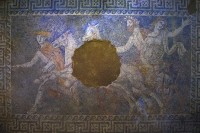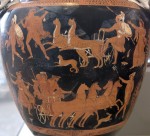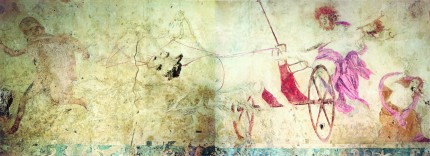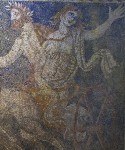 The east side of the mosaic in the second chamber of the 4th century B.C. tomb in Amphipolis has been uncovered revealing the red robe of the laureate figure and a young woman behind him wearing a white tunic tied under the bust with a red ribbon. She looks backwards, her red hair flowing, her left arm raised, hand open as in a wave. She wears handsome jewelry, a bracelet on her left wrist and a necklace of red beads around her neck. The red robe of the charioteer and the newly unearthed figure identifies the scene as the abduction of Persephone by Hades.
The east side of the mosaic in the second chamber of the 4th century B.C. tomb in Amphipolis has been uncovered revealing the red robe of the laureate figure and a young woman behind him wearing a white tunic tied under the bust with a red ribbon. She looks backwards, her red hair flowing, her left arm raised, hand open as in a wave. She wears handsome jewelry, a bracelet on her left wrist and a necklace of red beads around her neck. The red robe of the charioteer and the newly unearthed figure identifies the scene as the abduction of Persephone by Hades.
The laureate figure is the god of the Underworld, not, as was first posited before the entire mosaic was revealed, as the soul of the man interred in the tomb. Hermes leads the chariot in his role as psychopompos, guide of souls,  as he is traditionally depicted on other artistic presentations of the Persephone myth. Her looking back in anguish with raised arm is also a characteristic posture, see for instance the Persephone krater in Berlin’s Altes Museum, an Apulian red-figure volute-krater made in 340 B.C., within a few decades of the estimated date of the tomb. This is the first time a figural floor mosaic has been found in a Macedonian tomb.
as he is traditionally depicted on other artistic presentations of the Persephone myth. Her looking back in anguish with raised arm is also a characteristic posture, see for instance the Persephone krater in Berlin’s Altes Museum, an Apulian red-figure volute-krater made in 340 B.C., within a few decades of the estimated date of the tomb. This is the first time a figural floor mosaic has been found in a Macedonian tomb.
The scene, complete with Hermes running before the chariot and a red-haired Hades carrying away an equally red-haired Persephone as she reaches behind her for help, is also depicted in the royal tomb of King Philip II of Macedon at Aigai (Vergina). It is a mural, not a mosaic, a very rare instance of surviving Greek wall painting. Archaeologists suspect the duplicated theme is not a coincidence, that it may be an intentional reference to the art work in Philip’s tomb.

General Secretary of the Ministry of Culture Lina Mendoni described the potential connection in a press conference on the find:
“The scenes are linked with the cults of the Underworld, with the Orphic cult – the descent in Hades – and the Dionysian rites. The Head of the house of Macedon was the archpriest of these cults. I remind you of the recent research of the National Center of Scientific Research “Demokritos” in the residues of the mask found in the remains of bones of Philip. According to experts was the mask, which he wore Philip in Orphic rites. Therefore, the scene in our case has symbolic importance, which may indicate a relationship of the “occupier” of the tomb with the Macedonian House. The political symbolism is very strong in all periods.”
 Connected to the rulers of Macedon or not, whoever was buried in this tomb was someone of great wealth and importance. That was clear from the sphinxes in the entrance, confirmed by the caryatids and ultra-super underscored by this mosaic of exceptional quality.
Connected to the rulers of Macedon or not, whoever was buried in this tomb was someone of great wealth and importance. That was clear from the sphinxes in the entrance, confirmed by the caryatids and ultra-super underscored by this mosaic of exceptional quality.
The mosaic covers the entire floor of the room and is 4.5 by 3 meters (14’9″ x 9’10”). In order to preserve the work as excavation continues, workers have placed a layer of styrofoam over it and wood paneling over the styrofoam. A false floor will be built 15 inches above the protective layers so that archaeologists can start the slow process of unblocking the door to chamber three on the north edge of the mosaic.
Here’s a neato 3D rendering of the tomb highlights as rteal.orged this far from Greek Toys:
Kudos to a poster in my local newspaper blog, who had already argued that this could be about Persephone when the mosaic first appeared in the news. This could be the pre-christian version of doomsday resurrection, and to find it in a grave would be of no real surprise:
Myth of Hades abducting the vegetation goddess, here represented by her daughter Persephone: Hades appears with his chthonic horses, bursting through a cleft in the earth. Collaborator Zeus sends his messenger Hermes to the underworld to bring Persephone back. Hades first agrees to release her, but then arranges that each and every year, as soon as harvest is brought in, she has to spend three months together with him down there, until the seeds of the old crop are finally brought out on the fields.
To early vikings -and maybe not only to them- this would indicate raiding season.
Here a nice reconstruction of Amphipolis Mosaic:
http://taxcoach.gr/blog/%CF%84%CE%BF-%CE%BC%CF%89%CF%83%CE%B1%CF%8A%CE%BA%CF%8C-%CF%84%CE%BF%CF%85-%CF%84%CE%AC%CF%86%CE%BF%CF%85-%CE%BA%CE%B1%CF%83%CF%84%CE%AC-%CF%80%CE%BB%CE%AE%CF%81%CE%B5%CF%82-%CF%83%CE%B5-%CE%B1%CE%BD/
When I had the great pleasure of wandering around the tomb at Vergina a few years ago and that mural caught my eye in a serious way. When I saw the Amphipolis update on the mural a few days ago, I instantly thought of Vergina and wondered if the two might be purposefully connected through the image. I’d actually been meaning to stop by your blog and ask, but I see you beat me to it!
The restoration and reading of Mosaic from Tomb of Amphipolis
King Philip … stealing Persephone!
http://bouzanis.blogspot.gr/2014/10/king-philip-stealing-persephone.html